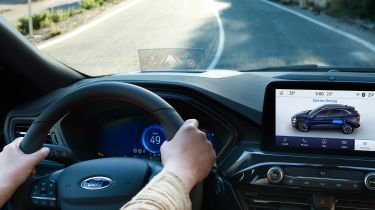What is lane-keeping assist?
Most new cars feature lane-keeping technology of some kind, but what is it, and how does it work?

Lane-keeping assist systems (LKAS) are just one of the vast array of safety features found on new cars today, the technology’s main function is to keep you and your passengers safe on motorways and dual carriageways by helping if you wander out of your lane unintentionally.
Systems that alert the driver by means of a visual cue, sound or vibration when the car starts to drift across a white line without indicating are often referred to as ‘lane departure warning’ systems (LDWS). Lane-keeping assist technology is the step beyond that because it is able to actually steer the car back into the centre of its lane as well as providing a warning.
Lane-keeping assist systems fall under level two of the vehicle autonomy levels set out by the Society of Automotive Engineers (SAE) as they provide ‘partial driving automation’ by actually altering the car’s course. The technology was developed to reduce instances of human error in high speed multi-lane driving and it will become mandatory on new cars from 2022.
The history of lane-keeping assist
Lane-departure warning technology first featured in 2000 on Mercedes Acrtos trucks in Europe to warn truck drivers if they were unintentionally drifting from their lane. If the truck was moving from its lane without an indicator turned on then the system would warn the driver with sound and vibration to imitate the sensation of driving over rumble strips.
In the early 2000s Nissan and Toyota introduced their own lane-keeping assistance on passenger vehicles sold in Japan. Since then, lane-keeping technology has made its way into a large number of production cars around the world with Honda, Mercedes, the Volkswagen Group and Ford amongst the manufacturers now offering vehicles with lane-keeping assist systems.
How does lane-keeping assist work?
Lane-keeping assist differs slightly between manufacturers but usually works by using a camera mounted behind the rear view mirror to see the lines on the road. The camera is used to work out where the car is in relation to the lines on the road and then the system can alert the driver if the vehicle is moving out of its lane without using an indicator.
Some systems alert the driver by vibrating the steering wheel or the sides of the driver’s seat while some also have visual warnings on the dashboard and sounds to draw attention to the potential problem. The alert will stop if an indicator is turned on or if the driver corrects the car’s line with the steering.

If the driver does not recentre the car then lane-departure assist can automatically correct the vehicle by adjusting the steering or braking on one side to adjust the path of the vehicle. Lane-keeping assist is designed for motorway driving so the system will activate once the vehicle is travelling over 40mph.
Many systems have two levels of assistance, a gentle nudge to remind you to stay in lane or an emergency mode that will provide a firmer correction if it detects that there could be more imminent danger.
Problems with lane-keeping assist
Lane-keeping assist systems can feel unnatural when the car corrects itself by braking or tugging on the steering wheel. They can be overridden by firmly steering against the correction but the feature can also be altered in most vehicles to be less sensitive or disabled if it becomes too distracting. Although, it will often be automatically re-enabled when the car is turned off and on again.
On narrow or twisting roads it is sometimes desirable or unavoidable for drivers to cross white lines without indicating. Perhaps you are moving to the side of the road to make way for an oncoming HGV or tractor or maybe you’re avoiding a pothole. In such instances it’s easy to trigger the lane-keeping assist software and the interventions of the system can become annoying.
Now read about how the latest car safety tech is tested...
Find a car with the experts


